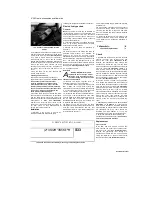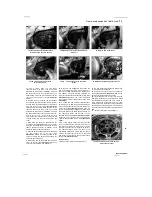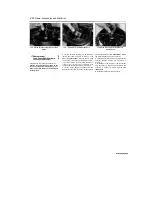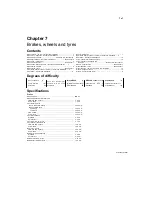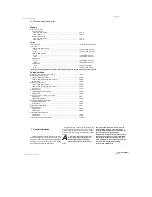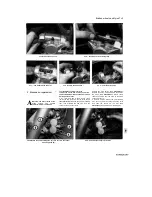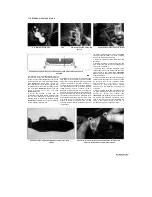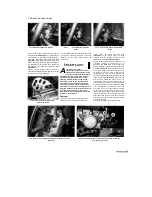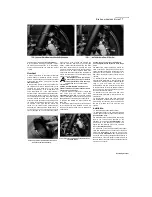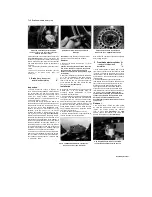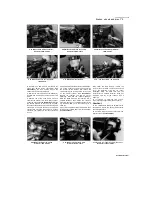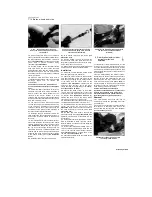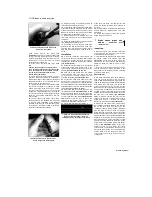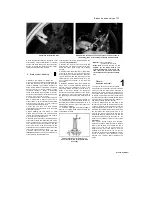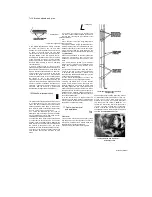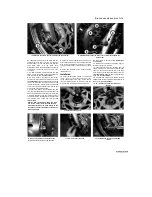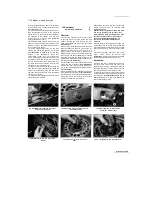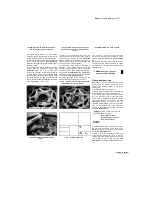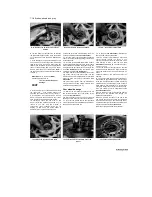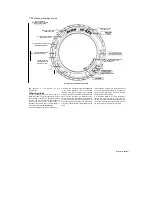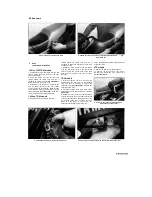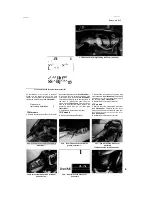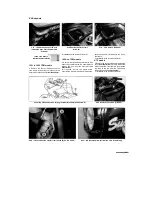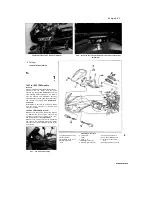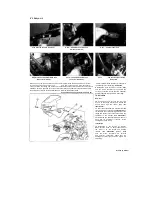
7«12 Brakes, wheels and tyres
6.10 Depress the piston and remove the
circlip from the cylinder
circlip
pliers,
remove
the
circlip
(see
illustration).
Slide out the piston assembly and
spring. If they are difficult to remove, apply low
pressure compressed air to the fluid outlet. Lay
the parts out in the proper order to prevent
confusion during reassembly.
11
Clean all of the parts with clean brake
fluid.
Caution: Do not, under any circumstances,
use a petroleum-based solvent to clean brake
parts. If compressed air is available, use it to
dry the parts thoroughly (make sure it's
filtered and unlubricated).
12 Check the master cylinder bore for corrosion,
scratches, nicks and score marks. If damage is
evident, the master cylinder must be renewed. If
the master cylinder is in poor condition, then the
caliper should be checked as well.
13 Inspect the reservoir hose for cracks or splits
and renew if necessary. If required, on TDM
models remove the screw and on XTZ models
the circlip securing the hose union to the master
cylinder. On TRX models the union is a push fit.
Pull the union from the master cylinder. Discard
the O-ring or bush (TRX models) as a new one
must be used.
14
The dust boot, circlip, piston, seal, primary
cup and spring are only available as a kit. Use all
of the new parts, regardless of the apparent
condition of the old ones. If the seal and cup are
not already on the piston, fit them according to
the layout of the old piston assembly.
15 Install the spring in the master cylinder so
that its tapered end faces the piston.
16
Lubricate the piston, seal and cup with clean
brake fluid. Install the assembly into the master
cylinder, making sure it is the correct way round.
Make sure the lips on the cup do not turn inside
out when they are slipped into the bore.
17 Install and depress the pushrod, then fit a
new circlip, making sure it is properly seated in
the groove.
18 Install the rubber dust boot, making sure the
lip is seated properly in the groove.
19 If removed, fit a new O-ring or bush (TRX
models) to the fluid reservoir hose union, then
push the union into the master cylinder and on
TDM and XTZ models secure it with its screw or
circlip.
Installation
20
If removed, install the clevis locknut, the
clevis and the base nut onto the master cylinder
pushrod end. Position the clevis as noted on
removal, then tighten the clevis locknut securely
(see illustration 6.8).
21
Install the master cylinder onto the footrest
bracket and tighten its mounting bolts to the
torque setting specified at the beginning of the
Chapter
(see illustration 6.5b and 6.7).
22
Align the brake pedal with the master
cylinder pushrod clevis, then slide in the clevis
pin and secure it using a new split pin, not
forgetting the washer
(see illustration 6.6).
23
Connect the brake hose banjo bolt to the
master cylinder, using a new sealing washer on
each side of the banjo union. Ensure that the
hose is positioned so that it butts against the lug
and tighten the banjo bolt to the specified torque
setting
(see illustrations 6.5a and b).
24
Secure the fluid reservoir to the frame with
its retaining bolt
(see illustrations 6.4a, b and
c).
Ensure that the hose is correctly routed, then
connect it to the union on the master cylinder and
secure it with the clamp
(see illustration 6.5a
and b).
Check that the hose is secure and
clamped at the reservoir end as well. If the
clamps have weakened, use new ones.
25 Fill the fluid reservoir with new DOT 4
■"'%
B
SL-'
:
!
I
7.4 Remove the banjo bolt and separate
the hose from the caliper; there is a
sealing washer on each side of the fitting
brake fluid (see
Daily (pre-ridej checks)
and
bleed the system following the procedure in
Section 8.
26
On TDM models, install the seat, and on XTZ
models install the right-hand side cover (see
Chapter 8).
27 Check the operation of the brake carefully
before riding the motorcycle.
,
7 Brake hoses, pipes and
unions
-
inspection
and
replacement
Inspection
1
Brake hose and pipe condition should be
checked regularly and the hoses renewed at the
specified interval (see Chapter 1).
2 Twist and flex the rubber hoses while looking
for cracks, bulges and seeping fluid
(see
illustration).
Check extra carefully around the
areas where the hoses connect with the banjo
fittings, as these are common areas for hose
failure.
3 Inspect the metal brake pipe (1996-on models)
and the banjo union fittings connected to the
brake hoses. If the fittings are rusted, scratched
or cracked, renew them.
Replacement
4
The brake hoses have banjo union fittings on
each end, with the exception of the rear caliper
hose on TDM models which has a joint piece. On
1996-on TDM models, the brake pipe splitting the
front brake hose has flare nuts. Cover the
surrounding area with plenty of rags and unscrew
the banjo bolt or flare nut at each end of the hose
or pipe, noting its alignment. On the rear caliper
on TDM models, counter-hold the hose nut and
unscrew the locknut and separate the hose from
the hose joint in the caliper
(see illustration
3.2b).
If required, unscrew the joint from the
caliper. Free the hose or pipe from any clips or
guides and remove it. Discard the sealing
washers on the hose unions
(see illustration).
5
Position the new hose or pipe, making sure it
isn't twisted or otherwise strained, and abut the
tab on the hose union with the lug on the
component casting, where present. Otherwise
align the hose or pipe as noted on removal.
Install the hose banjo bolts using new sealing
washers on both sides of the unions. Tighten the
banjo bolts to the torque settings specified at the
beginning of this Chapter. Do not overtighten the
brake pipe flare nuts. On the rear caliper on TDM
models, if removed, thread the joint piece into the
caliper using a new sealing washer and tighten
securely
(see illustration 3.2b).
Fit the hose
against the hose joint and tighten the locknut
onto the hose, counter-holding the hose nut to
prevent the hose twisting. Do not overtighten the
locknut. Make sure the hoses and pipes are
correctly aligned and routed clear of all moving
components.
Scaned by Stalker
7.2 Flex the brake hoses and check for
cracks, bulges and leaking fluid
1
Содержание XTZ750
Страница 174: ...UNREGISTERED VI ScanedbyStalker UNREGISTERED VI ...
Страница 207: ...Wiring diagrams 9 29 _____Scaned by Stalker 5 l 6o Cxj fi I JICM ...
Страница 208: ...UNREGISTERED VI 9 30 Wiring diagrams UNREGISTERED VERSION 01 ONREGISTEREDVI Scaned by Stalker ONREGISTERED VERSION 0 ...
Страница 209: ...I UNREGISTERED VI Wiring diagrams 9 31 ____ Scaned by Stalker UNREGISTERED VERSION OF PICTURE DESK ...
Страница 210: ...9 32 Wiring diagrams Scaned by Stalker ...
Страница 211: ...XTZ750 gauge Starter circuit Neutral Starter cut off relay switch rnotor ...

